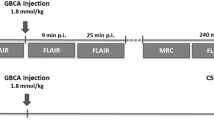Abstract
We hypothesize that infusion of chemotherapeutic agents directly into the fourth ventricle potentially may play a role in treating malignant posterior fossa brain tumors. Accordingly, we used a piglet model developed in our laboratory to test the safety of etoposide infusions into the fourth ventricle and to study the pharmacokinetics associated with these infusions. In 5 piglets, closed-tip silicone catheters were inserted into the fourth ventricle and lumbar cistern. Five consecutive daily infusions of etoposide (0.5 mg) were administered via the fourth ventricle catheter. Serum and CSF from both catheters were sampled for measurement of etoposide level by reversed-phase high performance liquid chromatography (HPLC). For CSF samples, area under the concentration-time curve (AUC) was calculated. Piglets underwent daily neurological examinations, a 4.7 Tesla MRI scan, and then were sacrificed for post-mortem brain examination. No neurological deficits or signs of meningitis were caused by intraventricular chemotherapy infusions. MRI scans showed catheter placement within the fourth ventricle but no signal changes in the brain stem or cerebellum. In all piglets, the mean fourth ventricular CSF peak etoposide level exceeded the mean peak lumbar etoposide levels by greater than 10-fold. Statistically significant differences between fourth ventricle and lumbar AUC were noted at peaks (ΔAUC = 3384196 ng h/ml with 95%CI: 1758625, 5009767, P = 0.0044) and at all collection time points (ΔAUC = 1422977 ng h/ml with 95%CI: 732188, 2113766, P = 0.0046) but not at troughs (ΔAUC = −29546 ng h/ml (95%CI: −147526, 88434.2, P = 0.5251). Serum etoposide was absent at two and four hours after intraventricular infusions in all animals. Pathological analysis demonstrated meningitis, choroid plexitis, and ependymitis in the fourth and occasionally lateral ventricles. Etoposide can be infused directly into the fourth ventricle without clinical or radiographic evidence of damage. Autopsy examination revealed ventriculitis and meningitis which did not have a clinical correlate. Etoposide does not distribute evenly throughout CSF spaces after administration into the fourth ventricle, and higher peak CSF levels are observed in the fourth ventricle than in the lumbar cistern.





Similar content being viewed by others
References
Sandberg DI et al (2008) Chemotherapy administration directly into the fourth ventricle in a new piglet model. J Neurosurg Pediatrics 1(5):373–380
Reddy AT, Packer RJ (1999) Medulloblastoma. Curr Opin Neurol 12(6):681–685
Rutka JT (1997) Medulloblastoma. Clin Neurosurg 44:571–585
Choux M et al (1982) Medulloblastoma. Neurochirurgie 28(Suppl 1):1–229
Silverman CL, Simpson JR (1982) Cerebellar medulloblastoma: the importance of posterior fossa dose to survival and patterns of failure. Int J Radiat Oncol Biol Phys 8(11):1869–1876
Suit HD, Westgate SJ (1986) Impact of improved local control on survival. Int J Radiat Oncol Biol Phys 12(4):453–458
Rutkowski S et al (2005) Treatment of early childhood medulloblastoma by postoperative chemotherapy alone. N Engl J Med 352(10):978–986
Slavc I et al (2003) Feasibility of long-term intraventricular therapy with mafosfamide (n = 26) and etoposide (n = 11): experience in 26 children with disseminated malignant brain tumors. J Neurooncol 64(3):239–247
Slavc I et al (1998) Intrathecal mafosfamide therapy for pediatric brain tumors with meningeal dissemination. J Neurooncol 38(2–3):213–218
Fleischhack G et al (2001) Feasibility of intraventricular administration of etoposide in patients with metastatic brain tumours. Br J Cancer 84(11):1453–1459
Sandberg DI et al (2000) Ommaya reservoirs for the treatment of leptomeningeal metastases. Neurosurgery 47(1):49–54; discussion 54–5
Jacobs A, Clifford P, Kay HE (1981) The Ommaya reservoir in chemotherapy for malignant disease in the CNS. Clin Oncol 7(2):123–129
Obbens EA et al (1985) Ommaya reservoirs in 387 cancer patients: a 15-year experience. Neurology 35(9):1274–1278
Shapiro WR et al (1977) Treatment of meningeal neoplasms. Cancer Treat Rep 61(4):733–743
Rubinstein LJ et al (1975) Disseminated necrotizing leukoencephalopathy: a complication of treated central nervous system leukemia and lymphoma. Cancer 35(2):291–305
Macdonald DR (1991) Neurologic complications of chemotherapy. Neurol Clin 9(4):955–967
Chamberlain MC, Kormanik PA, Barba D (1997) Complications associated with intraventricular chemotherapy in patients with leptomeningeal metastases. J Neurosurg 87(5):694–699
Bleyer WA et al (1978) The Ommaya reservoir: newly recognized complications and recommendations for insertion and use. Cancer 41(6):2431–2437
Reif S et al (2001) Bioequivalence investigation of high-dose etoposide and etoposide phosphate in lymphoma patients. Cancer Chemother Pharmacol 48(2):134–140
Gajjar A et al (1999) Chemotherapy of medulloblastoma. Childs Nerv Syst 15(10):554–562
Sirisangtragul C et al (2003) Cerebrospinal fluid pharmacokinetics after different dosage regimens of intraventricular etoposide. Int J Clin Pharmacol Ther 41(12):606–607
Henwood JM, Brogden RN (1990) Etoposide. A review of its pharmacodynamic and pharmacokinetic properties, and therapeutic potential in combination chemotherapy of cancer. Drugs 39(3):438–490
Acknowledgements
This work was supported by grants from the Miami Children’s Hospital Foundation and the Women’s Cancer Association of the University of Miami. Lumbar catheters used in these experiments were obtained through a grant from Medtronic. We thank Ms. Mariana Nunez for her assistance with preparation of pathological specimens.
Author information
Authors and Affiliations
Corresponding author
Rights and permissions
About this article
Cite this article
Sandberg, D.I., Crandall, K.M., Koru-Sengul, T. et al. Pharmacokinetic analysis of etoposide distribution after administration directly into the fourth ventricle in a piglet model. J Neurooncol 97, 25–32 (2010). https://doi.org/10.1007/s11060-009-9998-x
Received:
Accepted:
Published:
Issue Date:
DOI: https://doi.org/10.1007/s11060-009-9998-x




